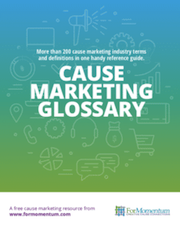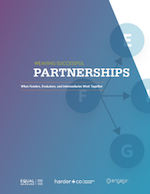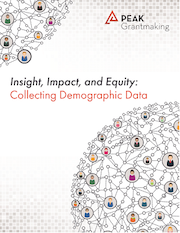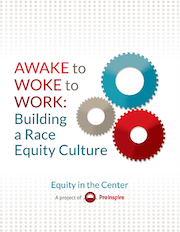Site Search
- resource provided by the Forum Network Knowledgebase.
Search Tip: Search with " " to find exact matches.

This handy reference tool contains the definitions for over 250 cause marketing industry terms used by savvy businesses and nonprofit organizations.
This report details how funders can embrace the power of young people to advance healthier and safer communities.
In this video, United Philanthropy Forum members and colleagues share some deeply moving stories of the role that racial equity plays in their personal lives. This is the third video in a three-part Forum video series on racial equity
A corporate member asked for what other corporations do regarding employee’s goal and objectives. Do they include volunteerism or volunteer activities as part of an employee’s review, or their annual goals?
Researched and written in collaboration with GEO, this toolkit provides a fresh set of resources for grantmaker CEOs, evaluation staff, and senior leaders to use to engage their boards and trustees in conversations about the importance of strategic learning in their decision-making and deliberation processes.

This report is designed to inform stakeholders in complex change strategies involving multiple partners, funders, intermediaries, and evaluators. It is framed by a literature review on partnership structures, trust building, and developing a learning culture, and offers case studies of three different partnerships. The report was commissioned by The James Irvine Foundation and collaboratively developed by Equal Measure, Engage R+D, and Harder+Company Community Research.
Please show your support of CNJG by displaying the following "Proud Member" graphic on your website, in social media posts, on publications, and in other communication efforts as appropriate.
This paper discusses developments in the conception and assessment of Creative Placemaking initiatives and, more generally, the assessment of comprehensive community-development strategies.
CNJG's 2018 Annual Meeting & Holiday Luncheon pre-meeting workshop with Michelle Greanias from PEAK Grantmaking focused on how foundation CEO’s, program officers, staff, and trustees could engage internally to put values-based grantmaking into practice.
It’s well established that employee engagement, defined as a willingness to do more than the job minimally requires, drives corporate performance. This report examines one potential driver of employee engagement - corporate volunteering, defined as employer-organized opportunities for employees to support a charitable cause or otherwise make a positive social impact with their contribution of time.
This report explores how companies are integrating diversity and inclusion into their corporate citizenship and responsibility priorities. With support from the Walmart Foundation, CECP led a year-long inquiry to identify and share actionable insights and best practices that corporate leaders can learn from and apply in their own companies. The report identifies six key D&I trends, as well as case studies, latest knowledge, methods, and valuable insights.
Assessing the performance of a foundation is notoriously challenging, but it is crucial to learning and improvement.
The Center for Disaster Philanthropy is proud to partner with Foundation Center, the leading source of information about philanthropy worldwide, to present this interactive dashboard, which provides an analysis of disaster-related funding by foundations, governments, corporations, and individuals.
The Center for Effective Philanthropy (CEP) collected candid, anonymous feedback over 15 years from more than 100,000 nonprofit leaders to produce this report detailing five things that nonprofits want their donors to know but may not be telling them directly.
Bolder Advocacy is a program of the Alliance for Justice – a national association of 130 organizations that are united by a commitment to a fair, just, and free America where everyone has equal access to justice and can fully participate in our democracy.

There is great interest among grantmakers in demographic data, but no consensus or shared purpose yet on what data should be collected and how it should be used. This preliminary research on demographic data collection serves to create a baseline understanding of where the field is in demographic data collection that covers both the process of data collection and current use of demographic data.
After more than 15 years promoting grantmaker practices that support nonprofit results, GEO is convinced that a strong culture inside foundations is critical for effective philanthropy. It’s virtually impossible to operate as an ally and partner to nonprofits if you are working inside a foundation whose values and culture run counter to that spirit.

Achieving race equity — the condition where one’s racial identity has no influence on how one fares in society — is a fundamental element of social change across every issue area in the social sector. In a sector focused on improving social outcomes across a wide range of issues, we need only look within our own organizations to understand why we have not yet achieved the depth of change we seek.
Tax Exempt Organization Search helps users find information about a tax-exempt organization’s federal tax status and filings.
Media Impact Funders partnered with Harvard University’s Shorenstein Center on Media, Politics and Public Policy to produce this case study report that surfaces pioneering funding practices in journalism.
